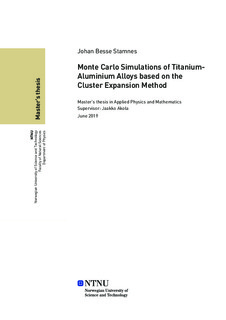| dc.contributor.advisor | Akola, Jakko | |
| dc.contributor.author | Stamnes, Johan Besse | |
| dc.date.accessioned | 2019-10-29T15:00:56Z | |
| dc.date.available | 2019-10-29T15:00:56Z | |
| dc.date.issued | 2019 | |
| dc.identifier.uri | http://hdl.handle.net/11250/2625262 | |
| dc.description.abstract | Titan-aluminium legeringer opp til 50% aluminium har blitt studert ved hjelp
av Monte Carlo-simuleringer som bruker en klynge-ekspansjonsmodell basert på
utregninger gjort med tetthetsfunksjonalteori. Kalkulatoren som er brukt, er
opensource-koden GPAW sammen med Perdew-Burke-Ernzerhof funksjonalet.
Flere utregninger for rent titans fysiske egenskaper har blitt gjort for å evaluere
og validere utførelsen av tetthetsfunksjonalteoriutregningene. Energiene til et
sett med strukturer med varierende sammensetning av titan og aluminium
i heksagonalt tettpakket gitterstruktur ble regnet ut og brukt til å lage en
klynge-ekspansjonsmodell for legeringen. Klyngene og de effektive klyngeinter-
aksjonene i denne modellen er kjapt diskutert før de er brukt til å kjøre Monte
Carlo-simuleringer på større strukturer med Metropolis-Hastings algoritmen.
Simuleringene er gjort i både det kanoniske og det semi-store kanoniske ensem-
blet. Formeringsentalpien for legeringen er utregnet opp til 50% aluminium,
og en fase med Ti3Al-krystallstruktur ble funnet. | |
| dc.description.abstract | Titanium-aluminium alloys in the range up to 50% aluminium have been stud-
ied with Monte Carlo simulations using a cluster expansion model based on
density functional theory calculations. The calculator used is the open-source
code GPAW, with the Perdew-Burke-Ernzerhof exchange-correlation energy
functional. Several calculations of physical properties of pure titanium are per-
formed to evaluate and validate the execution of the density functional theory
calculations. The energies for a set of structures of varying titanium-aluminium
composition on a hexagonal close-packed lattice were calculated and used to
develop a cluster expansion model for the alloy. The clusters and effective
cluster interactions of this model are briefly interpreted before used to perform
Monte Carlo simulations on larger structures with the Metropolis-Hastings al-
gorithm. Simulations are performed in both the canonical and the semi-grand
canonical ensemble. The enthalpy of formation for the alloy is calculated up
to 50% aluminium, and a Ti3Al crystal structure phase is identified. | |
| dc.language | eng | |
| dc.publisher | NTNU | |
| dc.title | Monte Carlo-simuleringer av titan-aluminium | |
| dc.type | Master thesis | |
